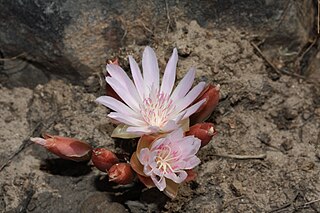
Bitterroot is a small perennial herb in the family Montiaceae. Its specific epithet rediviva refers to its ability to regenerate from dry and seemingly dead roots.

Alstroemeria, commonly called the Peruvian lily or lily of the Incas, is a genus of flowering plants in the family Alstroemeriaceae. They are all native to South America, although some have become naturalized in the United States, Mexico, Australia, New Zealand, Madeira and the Canary Islands. Almost all of the species are restricted to one of two distinct centers of diversity; one in central Chile, the other in eastern Brazil. Species of Alstroemeria from Chile are winter-growing plants, while those of Brazil are summer growing. All are long-lived perennials except A. graminea, a diminutive annual from the Atacama Desert of Chile.

Lathyrus latifolius, the perennial peavine, perennial pea, broad-leaved everlasting-pea, or just everlasting pea, is a robust, sprawling herbaceous perennial flowering plant in the pea family Fabaceae. It is native to Europe but is present on other continents, such as North America and Australia, where it is most often seen along roadsides.
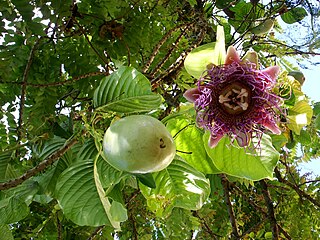
Passiflora quadrangularis, the giant granadilla, barbadine (Trinidad), grenadine (Haiti), giant tumbo or badea, is a species of plant in the family Passifloraceae. It produces the largest fruit of any species within the genus Passiflora. It is a perennial climber native to the Neotropics, Despite the Granadilla in its Name, it is not a true Passionfruit

Vinca major, with the common names bigleaf periwinkle, large periwinkle, greater periwinkle and blue periwinkle, is a species of flowering plant in the family Apocynaceae, native to the western Mediterranean. Growing to 25 cm (10 in) tall and spreading indefinitely, it is an evergreen perennial, frequently used in cultivation as groundcover.

Cleome houtteana, commonly known as spider flower, spider plant, pink queen, or grandfather's whiskers, is a species of flowering plant in the genus Cleome of the family Cleomaceae, native to southern South America in Argentina, Paraguay, Uruguay, and southeast Brazil. It has also been introduced to South Asia, including the Haor area of Bangladesh and India.

Tropaeolum majus, the garden nasturtium, nasturtium, Indian cress or monk's cress, is a species of flowering plant in the family Tropaeolaceae, originating in the Andes from Bolivia north to Colombia. An easily-grown annual or short-lived perennial with disc-shaped leaves and brilliant yellow, orange or red flowers, it is of cultivated, probably hybrid origin. It is not closely related to the genus Nasturtium.
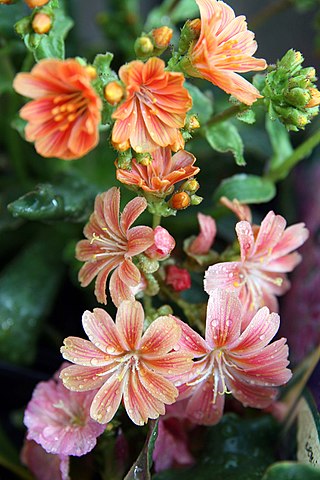
Lewisia is a plant genus, named for the American explorer Meriwether Lewis (1774-1809) who encountered the species in 1806. The native habitat of Lewisia species is rocky ground and cliffs in western North America. Native Americans ate the roots, which have also been used to treat sore throats.
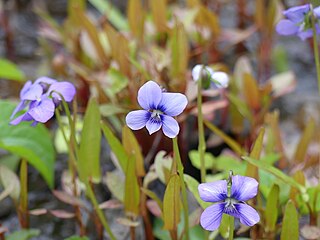
Viola cucullata, the hooded blue violet, marsh blue violet or purple violet, is a species of the genus Viola native to eastern North America, from Newfoundland west to Ontario and Minnesota, and south to Georgia. It is a recipient of the Royal Horticultural Society's Award of Garden Merit.

Hylotelephium spectabile is a species of flowering plant in the stonecrop family Crassulaceae, native to China and Korea. Its common names include showy stonecrop, iceplant, and butterfly stonecrop.

Erysimum cheiri, syn. Cheiranthus cheiri, the wallflower, is a species of flowering plant in the family Brassicaceae (Cruciferae), native to Greece, but widespread as an introduced species elsewhere. It is also treated as a hybrid under the name Erysimum × cheiri. It is widely cultivated as a garden plant.
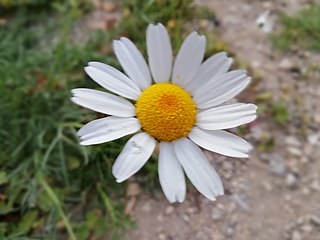
Argyranthemum frutescens, known as Paris daisy, marguerite or marguerite daisy, is a perennial plant known for its flowers. It is native to the Canary Islands. Hybrids derived from this species are widely cultivated as ornamental plants in private gardens and public parks in many countries, and have naturalized in Italy and southern California. There are many cultivars, but the most common has white petals.

Lewisia brachycalyx is a species of flowering plant in the family Montiaceae, known by the common name short-sepal bitter-root or shortsepal lewisia. It is native to the mountains of the southwestern United States and Baja California, where it grows in moist habitat such as meadows.

Lewisia cotyledon is a species of flowering plant in the family Montiaceae known by the common names Siskiyou lewisia and cliff maids. It is native to southern Oregon and northern California, where it grows in rocky subalpine mountain habitat.

Tradescantia sillamontana is a perennial evergreen herbaceous plant of the genus Tradescantia. This species is one of the most succulent and xerophytic, but at the same time one of the most attractive species of Tradescantia. It is endemic to dry areas of the State of Nuevo León in northeastern Mexico and can also be found in Spain and Italy.

Erigeron tweedyi, or Tweedy's fleabane, is a perennial herb in the family Asteraceae. It is native to the Rocky Mountains in Montana, Idaho and Wyoming.

Sempervivum ciliosum, the Teneriffe houseleek is a species of flowering plant in the succulent stonecrop family,Crassulaceae, native to the Balkans and Southeastern Europe. Despite a superficial resemblance, houseleeks are not closely related to the American cacti family. A colony-forming evergreen perennial plant, each individual rosette can grow to around 7.5 cm (3.0 in) high and wide, forming dense mats of up to 50 cm (20 in) wide.
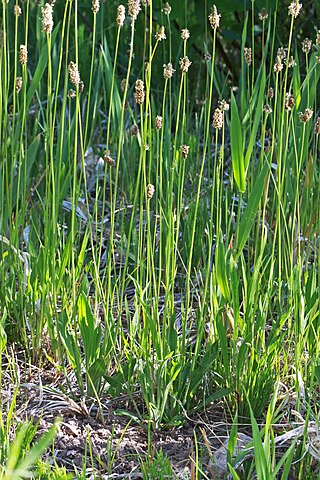
Plantago tweedyi, Tweedy's plantain, is a perennial herb in the plantain family. It is native to the western United States, from New Mexico and Arizona north to Montana.
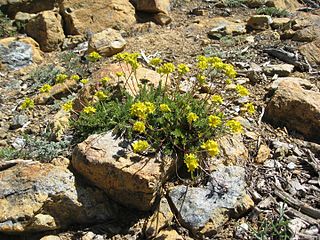
Ivesia tweedyi, Tweedy's mousetail or Tweedy's ivesia, is a perennial herb in the rose family. It is native to the Pacific Northwest in the United States, from Washington east to westernmost Montana.

Chionophila tweedyi, or Tweedy's snowlover, is a perennial herb in the plantain family. It is native to Idaho and Montana in the western United States.





















